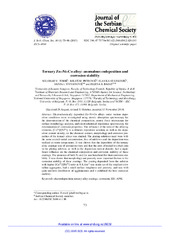Ternary Zn-Ni-Co alloy: anomalous codeposition and corrosion stability
Апстракт
Electrochemically deposited Zn-Ni-Co alloys under various deposition conditions were investigated using atomic absorption spectroscopy for the determination of the chemical composition, atomic force microscopy for surface morphology analysis, and electrochemical impedance spectroscopy for determination of corrosion properties. The influence of the ratio of the alloying elements, [Co2+]/[Ni2+], in a chloride deposition solution, as well as the deposition current density, on the chemical content, morphology and corrosion properties of the ternary alloys was studied. The plating solutions used were with the same overall metal concentration, free of additives and the deposition was realized at room temperature. It was shown that the deposition of the ternary alloy coatings was of anomalous type and that the ratio of nickel to cobalt ions in the plating solution, as well as the deposition current density, had a significant influence on the chemical composition and corrosion stability of the...se coatings. The presence of both Ni and Co was beneficial for their corrosion stability. It was shown that morphology and porosity were important factors in the corrosion stability of these coatings. The coating deposited from the solution with higher [Co2+]/[Ni2+] ratio at 8 A dm(-2) was made up of the smallest crystalline aggregates, had a small surface roughness and porosity, and was with quite uniform distribution of agglomerates and it exhibited the best corrosion stability.
Кључне речи:
electrodeposition / ternary alloy coatings / corrosion / EIS / AFMИзвор:
Journal of the Serbian Chemical Society, 2015, 80, 1, 73-86Издавач:
- Srpsko hemijsko društvo, Beograd
Финансирање / пројекти:
- Синтеза, развој технологија добијања и примена наноструктурних мултифункционалних материјала дефинисаних својстава (RS-MESTD-Integrated and Interdisciplinary Research (IIR or III)-45019)
- Ministry of Science and Technology of the Republic of Srpska
DOI: 10.2298/JSC260814113B
ISSN: 0352-5139
WoS: 000349739300008
Scopus: 2-s2.0-84915774875
Институција/група
Tehnološko-metalurški fakultetTY - JOUR AU - Tomić, Milorad V. AU - Petrović, Miloš M. AU - Stanković, Slavka AU - Stevanović, Sanja AU - Bajat, Jelena PY - 2015 UR - http://TechnoRep.tmf.bg.ac.rs/handle/123456789/3037 AB - Electrochemically deposited Zn-Ni-Co alloys under various deposition conditions were investigated using atomic absorption spectroscopy for the determination of the chemical composition, atomic force microscopy for surface morphology analysis, and electrochemical impedance spectroscopy for determination of corrosion properties. The influence of the ratio of the alloying elements, [Co2+]/[Ni2+], in a chloride deposition solution, as well as the deposition current density, on the chemical content, morphology and corrosion properties of the ternary alloys was studied. The plating solutions used were with the same overall metal concentration, free of additives and the deposition was realized at room temperature. It was shown that the deposition of the ternary alloy coatings was of anomalous type and that the ratio of nickel to cobalt ions in the plating solution, as well as the deposition current density, had a significant influence on the chemical composition and corrosion stability of these coatings. The presence of both Ni and Co was beneficial for their corrosion stability. It was shown that morphology and porosity were important factors in the corrosion stability of these coatings. The coating deposited from the solution with higher [Co2+]/[Ni2+] ratio at 8 A dm(-2) was made up of the smallest crystalline aggregates, had a small surface roughness and porosity, and was with quite uniform distribution of agglomerates and it exhibited the best corrosion stability. PB - Srpsko hemijsko društvo, Beograd T2 - Journal of the Serbian Chemical Society T1 - Ternary Zn-Ni-Co alloy: anomalous codeposition and corrosion stability EP - 86 IS - 1 SP - 73 VL - 80 DO - 10.2298/JSC260814113B ER -
@article{
author = "Tomić, Milorad V. and Petrović, Miloš M. and Stanković, Slavka and Stevanović, Sanja and Bajat, Jelena",
year = "2015",
abstract = "Electrochemically deposited Zn-Ni-Co alloys under various deposition conditions were investigated using atomic absorption spectroscopy for the determination of the chemical composition, atomic force microscopy for surface morphology analysis, and electrochemical impedance spectroscopy for determination of corrosion properties. The influence of the ratio of the alloying elements, [Co2+]/[Ni2+], in a chloride deposition solution, as well as the deposition current density, on the chemical content, morphology and corrosion properties of the ternary alloys was studied. The plating solutions used were with the same overall metal concentration, free of additives and the deposition was realized at room temperature. It was shown that the deposition of the ternary alloy coatings was of anomalous type and that the ratio of nickel to cobalt ions in the plating solution, as well as the deposition current density, had a significant influence on the chemical composition and corrosion stability of these coatings. The presence of both Ni and Co was beneficial for their corrosion stability. It was shown that morphology and porosity were important factors in the corrosion stability of these coatings. The coating deposited from the solution with higher [Co2+]/[Ni2+] ratio at 8 A dm(-2) was made up of the smallest crystalline aggregates, had a small surface roughness and porosity, and was with quite uniform distribution of agglomerates and it exhibited the best corrosion stability.",
publisher = "Srpsko hemijsko društvo, Beograd",
journal = "Journal of the Serbian Chemical Society",
title = "Ternary Zn-Ni-Co alloy: anomalous codeposition and corrosion stability",
pages = "86-73",
number = "1",
volume = "80",
doi = "10.2298/JSC260814113B"
}
Tomić, M. V., Petrović, M. M., Stanković, S., Stevanović, S.,& Bajat, J.. (2015). Ternary Zn-Ni-Co alloy: anomalous codeposition and corrosion stability. in Journal of the Serbian Chemical Society Srpsko hemijsko društvo, Beograd., 80(1), 73-86. https://doi.org/10.2298/JSC260814113B
Tomić MV, Petrović MM, Stanković S, Stevanović S, Bajat J. Ternary Zn-Ni-Co alloy: anomalous codeposition and corrosion stability. in Journal of the Serbian Chemical Society. 2015;80(1):73-86. doi:10.2298/JSC260814113B .
Tomić, Milorad V., Petrović, Miloš M., Stanković, Slavka, Stevanović, Sanja, Bajat, Jelena, "Ternary Zn-Ni-Co alloy: anomalous codeposition and corrosion stability" in Journal of the Serbian Chemical Society, 80, no. 1 (2015):73-86, https://doi.org/10.2298/JSC260814113B . .



